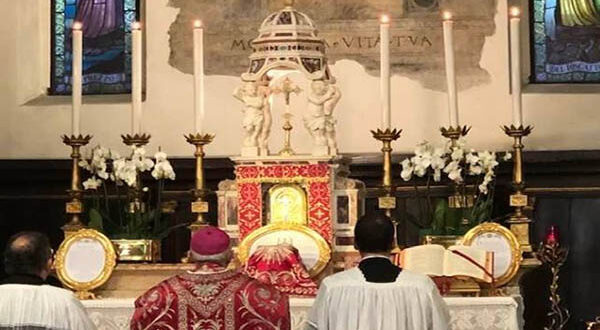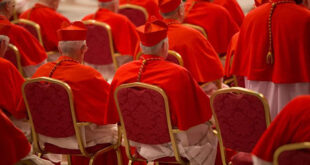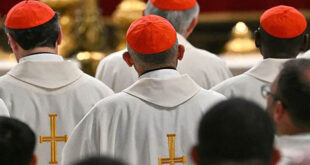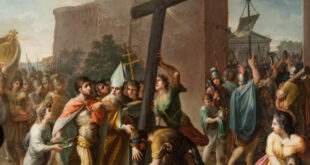Introduction: How many candlesticks should be used on the altar?
It might seem like a minor question, almost decorative. Does it really matter how many candlesticks are placed on the altar during Mass? In a world that tends to relativize signs and strip the liturgy of its symbolism, rediscovering the deep meaning of each liturgical element is an urgent necessity.
The light on the altar is not just decoration: it is a symbol of Christ, the light of the world (cf. Jn 8:12), a testimony of faith, a silent proclamation of God’s glory, and an echo of a Tradition that has crossed centuries.
In this article, we will explore the history, meaning, symbolism, and liturgical practice of candlesticks on the altar, to reclaim with depth what many today have forgotten or disregarded.
I. Origins: Light and Divine Presence in the Old Testament
From biblical times, light has been synonymous with the presence of God. In Exodus, God commanded the construction of a seven-branched candlestick (menorah) for the Tabernacle:
“You shall make a lampstand of pure gold… and you shall set up the lamps on it so that they give light in front of it.” (Exodus 25:31–37)
This candlestick was to burn continuously, as a sign of the divine presence among the people. From this comes a profound truth: the light burning near the altar is not just illumination, but a sacramental sign of the mystery being celebrated.
II. Jesus, Light of the World: The Theological Foundation of Using Candlesticks
Christ Himself said:
“I am the light of the world; whoever follows me will not walk in darkness, but will have the light of life.” (John 8:12)
At Holy Mass, the altar is Christ Himself: “Christ is the priest, the altar, and the victim,” teaches the Catechism of the Catholic Church (no. 1383). Therefore, the candlesticks on the altar are not external decoration, but a visible expression of this invisible truth: the presence of Christ-Light, who offers Himself out of love for His Church.
III. Historical Evolution: From the Catacomb to the Roman Missal
a) In the Early Centuries:
Christians celebrating in catacombs used oil lamps. The light not only enabled them to see in the darkness, but reminded them of spiritual vigilance and the sacred character of the act.
b) The Middle Ages:
The use of two, four, or six candlesticks on the altar became institutionalized, depending on the solemnity of the celebration. Light took on theological and hierarchical meaning.
c) Trent and the Roman Rite:
The Roman Missal of St. Pius V (1570) established a clear practice: two candlesticks for Low Masses, and four or six for Solemn Masses, with seven when a bishop officiates.
This practice has continued to this day in the traditional liturgy (Usus Antiquior), although it has suffered some confusion or abandonment in the ordinary form.
IV. How Many Candlesticks Should Be Used and Why?
According to Liturgical Tradition:
| Type of Mass | Number of Candlesticks |
|---|---|
| Low Mass (without singing) | 2 |
| Sung Mass (with deacon or subdeacon) | 4 or 6 |
| Pontifical Mass (bishop officiating) | 7 |
These numbers are not arbitrary, but filled with symbolism:
- Two: representation of the divine and human natures of Christ.
- Four: allusion to the four Gospels or the four cardinal points (universality of the sacrifice).
- Six: number of creation (cf. Gn 1), elevated to God in the Eucharist.
- Seven: perfection, fullness. In the Book of Revelation, the seven lamps represent the seven spirits of God (cf. Rev 4:5). The bishop, as a successor of the apostles, celebrates with fullness of signs.
V. The Symbolism of Light in the Liturgy
Candlesticks are not just “sources of light” but sacred signs. What do they symbolize?
- The Risen Christ: Each burning candle recalls that darkness has been overcome.
- Our Faith: Lighting a candle is a way of proclaiming: “I believe, I hope, I love.”
- Perpetual Sacrifice: As the wax slowly consumes, so the soul offers itself to God.
- The Prayer of the Faithful: As Psalm 141 teaches: “Let my prayer be counted as incense before you, and the lifting up of my hands as the evening sacrifice.”
VI. Pastoral and Spiritual Applications
a) In Parish Life:
- Recovering the traditional use of candlesticks according to liturgical solemnity is more than an aesthetic issue: it is visual catechesis, respect for the sacred.
- Parishes can educate the faithful by explaining why candles are lit, when and how many, restoring meaning to the rite.
b) In Personal Life:
- At home, placing a candle next to an image or crucifix is continuing the domestic altar, making Christ-Light present in the family.
- Teaching children to light a candle while praying turns them into liturgists of the home.
VII. And in the Modern Liturgy?
The General Instruction of the Roman Missal (GIRM), in number 117, states:
“On the altar or near it, there are to be at least two candlesticks with lighted candles, or even more, according to the nature of the different celebrations…”
Although it allows some flexibility, it does not abolish tradition. The minimum norm of two candles is maintained, but it invites adaptation based on solemnity.
What has been lost? The symbolic richness of six or seven candles—especially in episcopal celebrations—has often been neglected, usually due to ignorance. It is time to rediscover its value and return mystagogical splendor to the liturgy.
VIII. A Practical and Theological Guide for Today
How can this be applied in parish and personal life?
- Know the liturgical norm and explain it to the faithful.
- Do not reduce the sacred to the minimum: beauty also evangelizes.
- Form altar servers and sacristans in the meaning of candlesticks.
- Celebrate with dignity: a Mass with six candlesticks, even without singing, elevates the soul.
- Restore the use of the seventh candlestick in episcopal Masses.
- Educate through symbolism: explain to children and youth why wax, flame, and number matter.
Conclusion: The Light on the Altar Is Non-Negotiable
In a world oscillating between spiritual darkness and an overexposure to empty images, the light on the altar is a silence that speaks, a fire that burns, God who remains.
Rediscovering the importance of the number and placement of candlesticks is not nostalgia: it is faithfulness to the faith handed down to us.
The altar is Calvary. And upon it, as on Golgotha, there is only one Light that illuminates all: Christ crucified and risen, who with every lit candle tells us once again:
“You are the light of the world… No one after lighting a lamp puts it under a bushel basket.” (Mt 5:14–15)
May every candle upon the altar be a small flame in the heart of every faithful soul.
May visible beauty lead us to the invisible mystery.
And may each Mass make us a reflection of Him who is Eternal Light.






